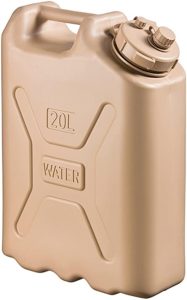Access to drinking water is the most important thing to secure in the event of a calamity like a natural disaster. Humans can only survive for about three days without water.
While 12-24 packs of water bottles found at the grocery store are convenient to purchase, they are not the most economical nor robust option.
For many, one of the easiest ways to ensure access to safe drinking water is to store it yourself.
A rule of thumb to aim for is storing a minimum of 1-2 gallons (3.79-7.58 litres) of water per person per day. To start with, you might target a one week supply and build from there.
A family of three would require 21-42 gallons for a week of sustenance. To make it easy to visualize, that is about 210 bottles of wine, or 17.5 cases.
That’s a lot of water to store.
There are many types of containers that you can use to store water, but ideally they are:
- BPA-free (Bisphenol-A, an industrial chemical that is not good for you).
- A dark color so that sunlight cannot penetrate. Sunlight encourages the growth of bacteria, fungus and other microorganisms.
- New and not used. If they were previously used to store other liquids, they could be very hazardous to your health.
- Easily stored.
From large to small, here are some of the types of containers you can purchase.
Rainwater Tank
These can be 100 gallons and through regular use in your garden or backyard, they are consistently refreshed. Great to use to provide drinking water for pets, flushing the toilet, and cleaning.
Typically the hose spigot is at the bottom of the tank so no pump is required.
55 Gallon Drums
These are the ubiquitous blue drums that are popular in the prepping community. At full capacity they are heavy, around 400 lbs, and require a dolly or other method to transport them.
55 gallon drums require a way to pump out the water.
Water Bricks
These are perfect for apartment dwellers or people who don’t have much extra space. They stack up, they are easy to transport (3.5 gallons of water weighs about 29lbs), and they can be stored under the bed or in the closet.
Jerrycan Water Containers
These aren’t stackable like Water Bricks, but they are easier to transport as they less bulky and have a comfortable handle. In a bug-out situation, they’re simple to throw in the back of a car.
My favorite is the 20L (5.28 gallon) made by Scepter, manufactured using opaque food-grade plastic with a minimum wall thickness of 0.1 inches for durability.
Each one of these will provide one person with about 3 days of water.

Bathtub
In an emergency situation, filling your bathtub is smart. But most bathtubs are filthy and the water would need to be diligently purified to be safely drinkable. Far better would be to use a product like a waterBOB, which are built for storing water in tubs.
Treating water for long term storage
For multi-year storage it’s important to treat water to prevent growth of bacteria and other microorganisms. Bleach is readily available, and can be used to disinfect water effectively, but it tastes awful.
A better option would be solutions over the counter, like adding drops of Aquamira, that don’t impart a bad taste to the water.
Once the water has been purified it’s a good idea to label the containers with dates of when they were filled.
